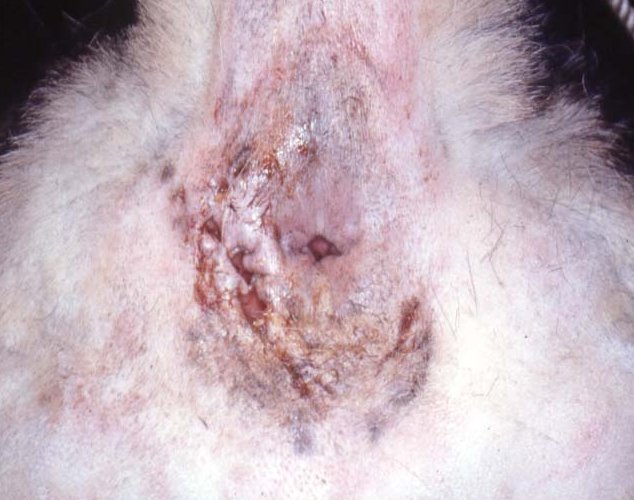
|
A NAL FURUNCULOSIS (Perianal fistulas)Note for Pet Owner s:This information is provided by Provet for educational purposes only. You should seek the advice of your veterinarian if your pet is ill as only he or she can correctly advise on the diagnosis and recommend the treatment that is most appropriate for your pet. Topics on this Page: |
Description
Anal furunculosis (or perianal fistulas) are deep unsightly sinuses that track
through the skin, sometimes with flat open areas of ulceration. They are usually
confined to the skin around the anus, but in severe cases they can spread as far
as the flanks and run down the inside of the hindlegs. Technically they are NOT
fistulas because they course only within the skin and do not open into another
organ. Although they are near the anal sacs (scent glands) the sinuses do not
connect with them, nor do they connect with the rectum or colon.
Typical furunculosis lesions around the anus of a German Shepherd Dog
Cause
The cause of anal furunculosis is unknown.
The sinuses are not caused by infection, although secondary bacterial infection may be present.
Some authors have suggested that dogs that carry the tail tightly against the anal region may be predisposed to develop furunculosis due to poor ventilation but this has not been proved. Others have suggested that there may be impaction of the local crypts of Morgagni.When the sinuses are tracked back to their source they do not reach the anal sacs (scent glands) or the rectum or colon, as was suggested by some authors who were comparing the disorder with Crohne's Disease in humans..
Breed Occurrence
The disease occurs almost exclusively in the German Shepherd Dog. It is seen in
both sexes and in German Shepherd crosses as well. It usually initially occurs
in dogs aged 3-8 years.
Signs
The skin lesions are irritable
resulting in self-trauma, and affected dogs often lick and bite at the
affected region. There may be pain, difficulty (or reluctance) and straining
during defaecation. If the lesions spread down the legs the dog may walk with
a straddled gait. Affected dogs are often tail-shy and won't allow people near
their rear end, or to touch or lift their tail.
Complications
Diagnosis
The diagnosis is confirmed at physical examination and by ruling out other
causes for the lesions
Treatment
Treatment with drugs alone has generally not been successful except for cyclosporinmay be efficacious CLICK HERE for more information.
If therapeutic treatment does not work there are
two main forms of surgical treatment :
Because of the extent of the lesions these treatments often have to be
repeated several times. Prognosis Long term problems
The prognosis is guarded as recurrence is common
Updated October 2013
d>
